Definition and Forms of Lyric Poems
Lyric poetry is a form of literature that expresses personal and emotional thoughts, as opposed to narrative or epic literature which tells stories. Lyric poetry has been around since the days of Homer and has been one of the most popular forms of poetry ever since. The term “lyric” comes from the Greek term lyre, which was an ancient stringed instrument that was used to accompany song. Lyric poetry is a type of poem in which the poet expresses his or her own individual thoughts, feelings, and emotions.
The most common form of lyric poetry is the song lyric, where the poet writes words to fit a musical score. There are also other forms of lyric poetry such as the sonnet, a 14-line poem that usually follows a specific rhyme and meter, or the ballad, which is a type of folk poem with a story-telling element.
Characteristics of Lyric Poems
Generally, a lyric poem has many of the same characteristics as any other type of poem: it has rhythm, sound and imagery, and often includes rhyme and meter. But, it also has some unique qualities that set it apart from other genres of poetry.
One of the defining characteristics of lyric poetry is its focus on the poet’s inner experience, whether it be sadness, joy, confusion, or anger. Lyric poetry is often a reflection of the poet’s emotional state and personal journey.
Another characteristic of lyric poetry is that it tends to be self-contained. Unlike narrative poetry, which often tells a story, lyric poetry paints a snapshot of a single moment in time. Lyric poems are usually short and often convey a single idea or emotion.
Finally, lyric poems often use personal language and a conversational tone, making them easier to relate to than other types of poetry. Many lyric poems read like prayers or confessions, allowing the reader to connect with the poet’s inner experience.
Examples of Lyric Poetry
Throughout history there have been many great lyric poets such as William Shakespeare, John Keats, and Emily Dickinson. But some of the most popular examples of lyric poetry come from contemporary poets such as Langston Hughes, Maya Angelou, and Amy Lowell. Here are some examples of popular lyric poetry:
William Shakespeare’s “My Mistress’ Eyes”
Maya Angelou’s “Still I Rise”
John Keats’ “Ode to a Nightingale”
Amy Lowell’s “Patterns”
Langston Hughes’ “Harlem”
The Power of Lyric Poetry
Lyric poetry has the power to move and inspire readers in a way that few other forms of literature can. It is a powerful medium for expressing emotion and it can be used to explore complex themes and ideas. It is also a great tool for connecting with the past. By reading lyric poetry, we can gain insight into the lives of previous generations and learn something about our shared humanity.
Finally, lyric poetry can be used to open up conversations and create connections. It is a way of communicating and expressing ideas and opinions, and it can be used as a form of protest against injustice or as a way of celebrating life and the world around us. It is one of the oldest forms of literature and it still has the power to move and inspire readers today.
Readers of Lyric Poetry
Lyric poetry has a wide and varied audience, with readers of all ages, backgrounds and ethnicities. Many of the most celebrated lyric poets in history have come from minority communities, such as African American poets Langston Hughes and Maya Angelou, and Latin American poet Pablo Neruda.
The readership of lyric poetry is expanding rapidly in the digital age, with lyric poems being shared, liked and commented on across social media platforms such as Twitter and Instagram. This has facilitated the spread of lyric poetry among new and diverse audiences, allowing more readers to access and enjoy this powerful form of literature.
Poets and Performance
Lyric poetry can be performed both as written text and as a spoken piece. Performance poets often use vocal techniques to bring their poems to life onstage, using tone of voice, inflection and projection to emphasize certain words and create rhythm. Performance poets often use props such as music, costumes, and props to create an immersive performance experience for their audiences.
The rise of slam poetry has made performance poetry more popular and accessible than ever before. Slam poetry competitions are held in cities around the world, often with cash prizes for the best performers.
Modern Interpretations
Modern lyric poetry is often a combination of traditional forms such as the sonnet and free verse styles, and can also incorporate elements of rap and hip-hop. Many contemporary poets are also influenced by technology and social media, and use these influences in their poetry to create something unique.
Much of modern lyric poetry focuses on issues such as politics, gender, race, and identity. It can be a powerful tool for raising awareness and promoting positive change.
Techniques in Lyric Poetry
Many lyric poets use the same poetic techniques to write their poems. These techniques include, but are not limited to, meter and rhyme, alliteration, repetition, and metaphor. Meter and rhyme correspond to the rhythm and sound of the poem, while alliteration, repetition and metaphor are used to convey imagery and emotion.
The use of these techniques can help to make the poem more powerful and evocative. By playing with the sound, structure, and imagery of a poem, lyric poets can create a compelling and memorable experience for their readers.
Influence of Lyric Poetry
The influence of lyric poetry can be seen in many other forms of literature, from books and plays to music and film. Lyric poetry often provides the basis for popular song lyrics and has been adapted into great pieces of literary works.
The influence of lyric poetry can also be seen in other art forms, such as visual art and theatre. Its powerful emotion can be interpreted and expressed in many different ways, making it a versatile and inspiring form of art.
Value of Lyric Poetry
Lyric poetry is a valuable tool for expressing and communicating emotion in a creative and meaningful way. Its ability to capture a moment in time can be a powerful and inspiring experience for both the reader and the poet.
Through lyric poetry, we can connect with our own emotions and the emotions of others, and find new ways to understand and appreciate the world around us. Lyric poetry can be a source of comfort and strength, as well as a way of expressing difficult concepts and emotions.
Conclusion
Lyric poetry has been around for centuries and continues to be one of the most popular forms of poetry today. It is a powerful tool for expressing emotion and exploring complex themes, and its influence can be seen in many different forms of literature, art and music.
The power of lyric poetry lies in its ability to capture a snapshot of an emotion or a moment in time and convey it through words. It is a valuable form of expression that is accessible to readers and writers of all ages, backgrounds and ethnicities.


